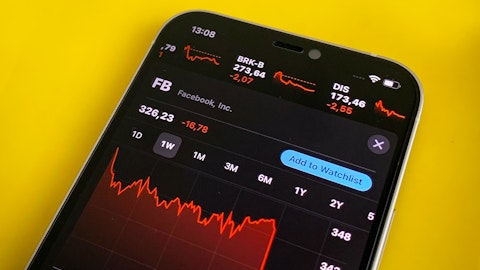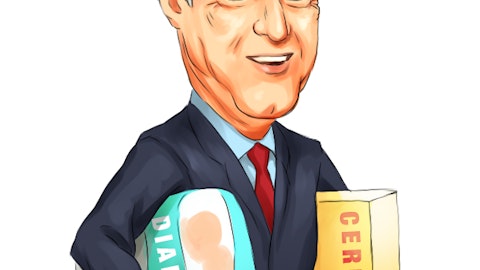Jim Peters: Yes. Sam, maybe just to add a little bit to what Mark says is some of that confidence comes from many of these are due to actions we executed during 2022. And so we’re already beginning to see that in our exit run rate. And then additionally, if you look at the material environment and as Mark said, this is our best estimate right now but over the last couple of years in a volatile environment, we’ve been pretty good at putting an estimate around what we think materials will do for the year. So we feel good about all of those numbers.
Operator: Your next question comes from the line of Mike Rehaut from JPMorgan.
Mike Rehaut: First, I’d love to dive in a little bit to the assumptions you’re making in 2023 for InSinkErator. I know that for sometimes in prior acquisitions, divestitures here, sometimes have been a little more hesitant to break out the impact of acquisitions. But given the $3 billion purchase price, I think it would be really helpful for investors to understand what the contribution is expected in 2023 on sales and margins and on a quarterly basis in the upcoming year to kind of give us a sense of how the acquisition is doing, I think, would be very, very helpful.
Jim Peters: Mike, this is Jim. And maybe I’d start with when we acquired InSinkErator, we talked about it having revenues above $600 million and we expect it to continue in that range and continue to grow it. We’ve said that the margins are above our average and very strong margins and we expect that. On a total basis, we think net of interest and everything but with the tax benefits, it gives us about $1 of additional EPS as we go into 2023. But it also gives us $100 million plus of free cash flow and that’s the good thing about this business. And part of the reason why we bought it is a very consistent performer but also a very consistent generator of cash. And so that’s what we expect right now headed into 2023 based on what we’ve seen in our first 2 months of ownership.
Marc Bitzer: And Michael, it’s Marc. Just to add to this one. It’s now 2 or 3 months where we have ownership of this one. I would say, first of all, from an environment, it’s incinerator plays in the same kitchen as we have our major appliances. So the same external environment which we described earlier also applies to that segment. So the demand environment for the first half will be soft and we expect some pickup in the back half. Having said all that, the most important thing, the — this is a high-margin business and we saw very impressive stability and sustainability of the margins, both in the first 2 months — or last 2 months of ’22 and the first month of ’23. So March looked very good. And then more from an operational perspective, there is a major and is segment, you don’t have product innovations every year but there’s a major generation of product innovation coming in April, May.
And honestly, from outside, I never thought you could be excited about garbage disposal but I did. So that is a very, very exciting product which comes out in April, May. It brings us not only high consumer benefits but also a further cost reduction this month. So we feel very strong about this business from a structural run rate from a product pipeline and particularly once the housing picks up which it will do at one point, we will really like this business.
Mike Rehaut: Okay, I appreciate it. I guess, secondly, you gave out guidance, I believe, saying that 35% to 40% of your earnings would be in the first half. When I look at Slide 16 and I see that you’re not going to have the benefits really start until in 2Q in terms of the cost takeout and raw material benefits. But you do have first quarter being kind of flattish year-over-year. How should I think about first quarter EBIT or margins versus fourth quarter, if you’re not having any incremental headwinds, should we expect to see any type of significant improvement on a margin basis sequentially? And then I think also, lastly, I just want to make sure I heard right. You talked about North America being at 14% by the end of the year. I’m just not sure if you’re intending to say that all else equal, that could be a starting point for 2024. I know you’re not talking about 2024 yet but just making sure I understand that 14% comment correctly.
Jim Peters: Yes, Michael, this is Jim and I’ll get started, then I’ll let Mark kind of add to it. But if you look at the seasonality and what you’re referencing on Slide 16, what you have to remember in the first quarter of the year is, one, we have a higher cost layer of inventory right now. That’s just in if you think about when we have close to 2 months of inventory on hand, that will work through our system through the first quarter and then we begin to realize the benefit of the lower material cost as you exit Q1 and into Q2. So your question on sequential margin improvement, yes, we expect to see that. Second is, as I mentioned, many of our cost reduction programs were put in place in 2022 but we continue to put more in place in early 2023.
So you’ll see a ramp-up of the additional cost savings beyond materials that will help the margin. So again, as we looked at it and said, we think about 35% to 40% of the earnings comes in the first half of the year. And then those are the big drivers that take it out later in the year. We also expect the demand environment to be a little bit more negative year-over-year in the first half of the year and then more stable on a year-over-year basis in the second half of the year. To your question on the NAR margins, too, if you think about the different things we’ve talked about, whether it’s the material, that does have a significant impact on NAR, so we do expect those margins to ramp up throughout the year. Additionally, in the first quarter, you have a small tail of just dealing with some of the issues we had in Q4 that we now say are behind us but they were resolved in January.
So that also will have an impact on the NAR margins in but then it began to improve throughout the year.
Marc Bitzer: So Michael, let me just specifically add on the North America margins. And of course, the North America margins may drive the company margins. As you rightfully pointed out, on a full year basis, last year, we had 11.5% margin in North America and we now guide towards 12%. So on a full year base, it doesn’t look like a big move. But given the volatility we all experienced for the last couple of years, right now, it’s probably more of a sequential view which makes sense as opposed to year-over-year. So on a sequential basis, we had in Q4, 5.8% which we always said are not representative of our structural run rate. The important thing is what Jim alluded to, we had 2 specific elements in our Q4 margin. One was still the tail end of a production reduction which we explained in the last earnings call.
And two, was this one-off supply issue. Put a number behind these ones, that’s roughly about $100 million profit impact. So by definition, you should have the absence of this 1 in Q1. So advise to the margin which we had and then you probably get to a margin of 8-plus percent. To be clear, this is not a guidance but that’s what you should expect and that’s what we would expect from our internal run rate. So you will see sequentially a significant margin expansion in Q1 and then throughout the year as the raw material benefits start kicking in, as we explained on Page 16, every quarter, we would see a sequential margin improvement with exit run rate which has been getting much closer again to our long-term value creation targets.
Operator: Your next question comes from the line of Liz Suzuki from Bank of America.





